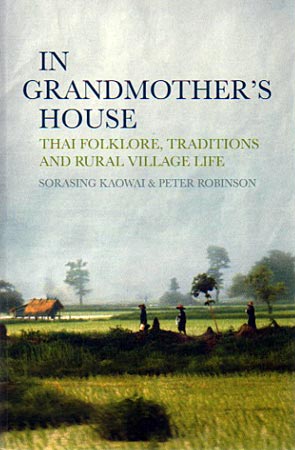About the Authors
Sorasing Kaowai (born 1980) recounts life in a rural remote village from his days as a child till he left the village in 1993. He was raised by his grandmother Say Krariangdee, who died at the age of 70 in 1991. His formative years occurred during a time of rapid change in the village. Co-author Peter Robinson road non-fiction works as Phra Peter Pannapadipo :
Phra Farang : An English monk in Thailand, Little Angels, One Step at a Time, and Good Morning Buddha. He established the SET Foundation in 1994. The SET Foundation support Thai students at high school, college and university.
Sorasing Kaowai & Peter Robinson : In Grandmother's House [ISBN 978-981-08-6658-7]
Life is simple, and evolves around work in the rice fields. The villagers work hard for a living, but are self-sufficient and provide for all necessities themselves. Only some metal tools and weaving looms have been 'imported' long time ago and are still in use. Though they are poor, people never go hungry. Besides rice and vegetables, various small animals and insects are caught to supplement the diet.
 |
In grandmother's house by Sorasing Kaowai and Peter Robinson |
|
During grandmother's time the village was very remote. A trip to closeby Uttaradit (just 25 kilometers away) took up a whole day. There are no proper roads, fastest transport is by water buffalo. Grandmother hardly ever left the village. She is the matriarch not only of her family, but also of the village. As such, she is a figure of some authority, and the other villagers seek her advice, also for health matters.
Sorasing recounts how she used to prepare various health potions from herbs he helped gather in the surrounding forest. Grandmother learned her skills from her own family years before. While villagers consult her for minor ailments, a village shaman deals with more serious health problems. It is apparent that these skills are not shared with the whole village, but rather are transferred as between a teacher and a student (usually a direct relative). As such, a generational gap, like children leaving the house to go work in the city, is enough to make knowledge, acquired over decades or centuries, disappear. Most people, even up to the 1980s, are illiterate, and little is written down.
Village life could at time be hazardous. Sorasing tells us hardly ever a day went by without him seeing a snake. Various poisonous and non-poisonous snakes are mentioned, the most fearsome being King Cobras, and huge pythons. We learn that it is not advisable to have a garden just around the house, since snakes and other nasty animals may look for some shade in between the bushes.
Ghosts are another matter, and the author(s) describes at least 15 different types of ghosts, most but not all rather unfriendly, who inhabit the village and surrounding forest. Ghosts mostly are the spirits of dead people, who somehow remain bound to earth. This is the reason many ceremonies are performed after somebody dies, to make sure his spirit will eventually let go, and find another realm (or new birth).
Grandmother's tales also include encounters with pygmies, and a local Bigfoot. We wonder if some of these stories were just tales to keep small children from misbehaving.
In grandmother's days, there was only one harvest a year in the village. Many foreigners living in Thailand may have seen ricefields a thousand times, without knowing all the stages in producing the crop. Well, you can find out in this book.
Village life centers around work in the rice fields. There is little time for entertainment, education of children is hardly existing. During the 1980s a moving movie theatre visits the village a few times a year. Once a week the villagers go to the monastery to hear the sermon of one of the few local monks.
The only important period of celebration is Songkhran. In the village, it is not an exuberant celebration with a lot of water splashing, but rather a time to pay respects to the monks and to one's elders. People living in the city come back to the village, to visit relatives. Somehow one gets the impression (maybe wrong) that very little social interaction is taking place outside the direct family. Surely there must have been times in the year when less work needed to be done, for example during the months preceding the rice planting season. Did the villagers hang out together, telling stories, playing games? The last chapter of the book is dedicated to the funeral arrangements for grandmother.
We were not that surprised by what village life entailed (entails). Maybe we were well prepared by our Thai language studies at A.U.A. where a lot about Thai culture and village life is included in the lessons. What is most striking is not how life was decades or centuries ago, but how rapid change came. While Sorasing tells the stories of his grandmother, he also tells us about life as it was during his childhood. We are talking about the late 1980s, early 1990s here, just 20 to 25 years ago.
Surely, work in the ricefields is still hard. But transport, communications, entertainment, education, have changed in a way hardly conceivable before it happened.
A final note. Sorasing just spends a few pages talking about his mother (the story after all is about his grandmother). His mother died at a young age, just a few years after the death of his grandmother. The story of her sacrifice (going to earn money in the city for her family and Sorasing's education), premature death and funeral, is one that squeezes the heart.
In Grandmother's House, offers a good insight in Thai folklore, and rural traditions, developed over many centuries, that are now disappearing, but should not be forgotten.
|